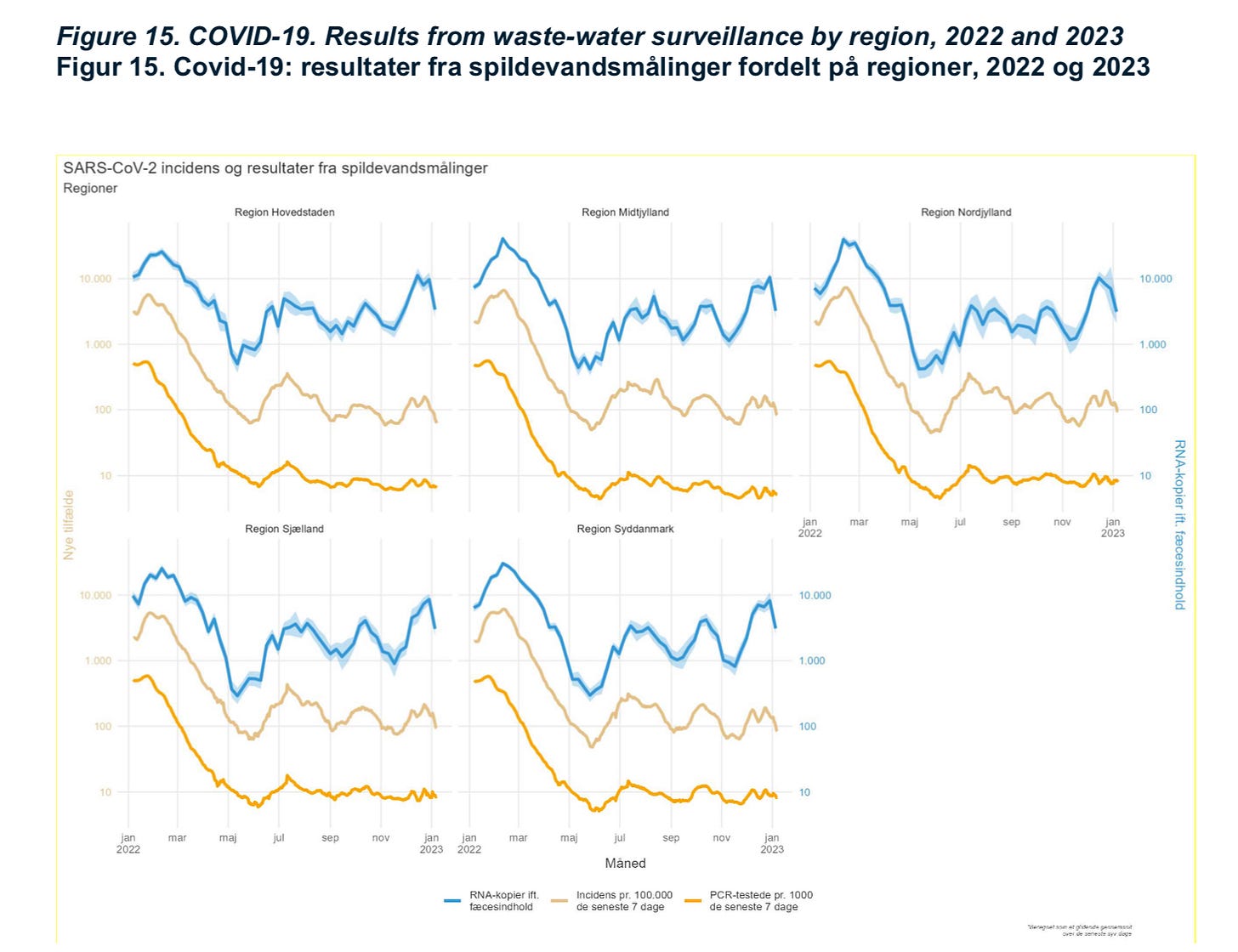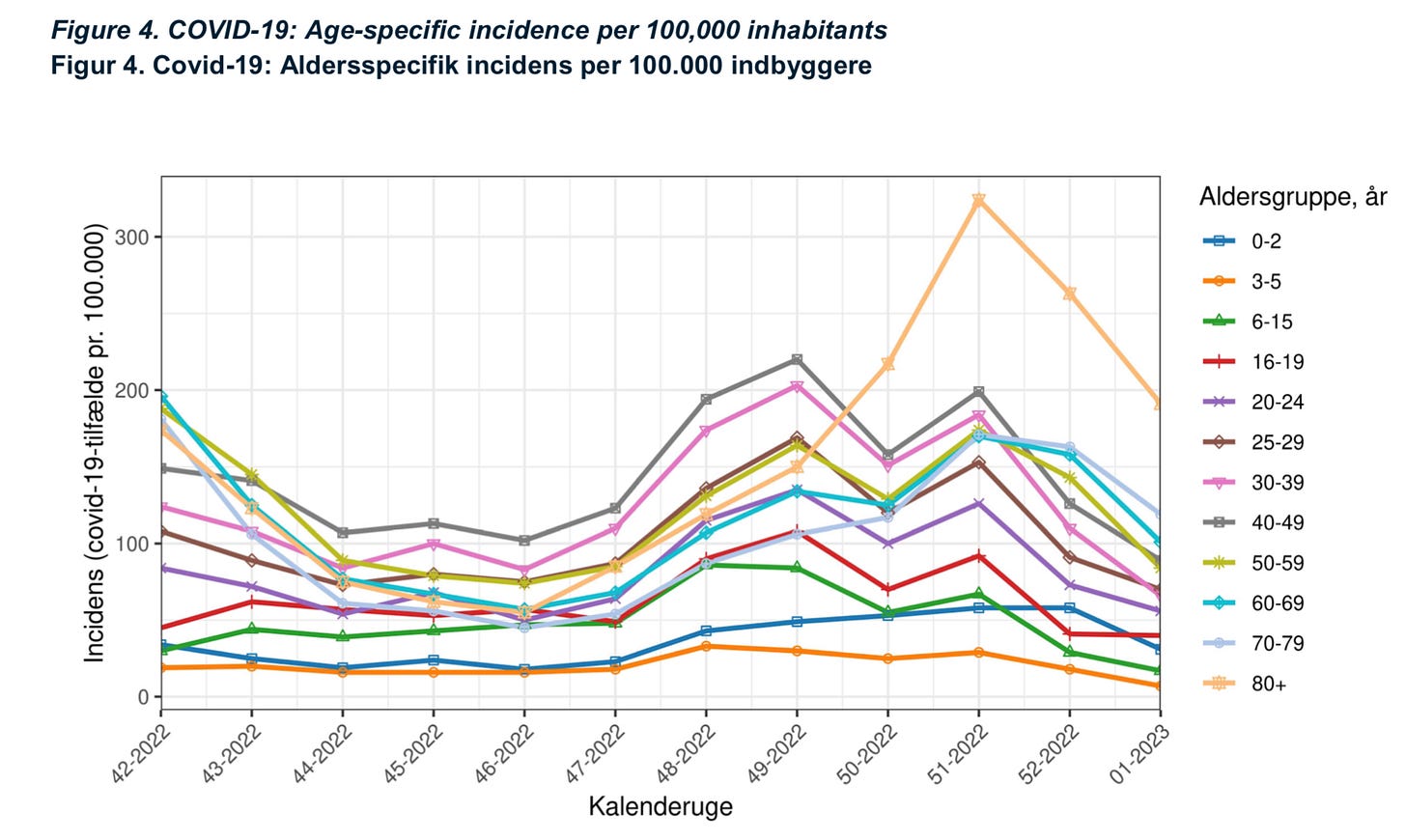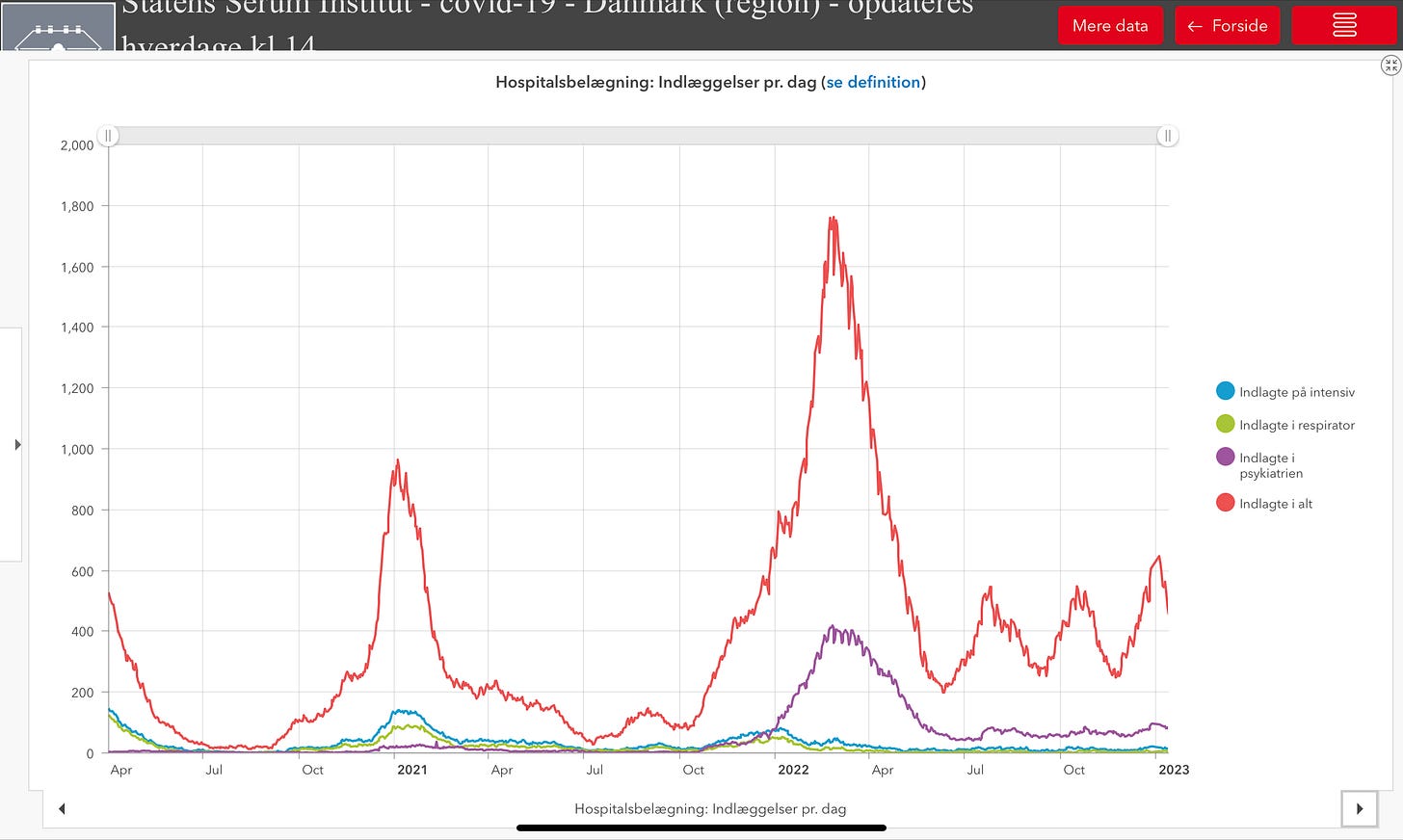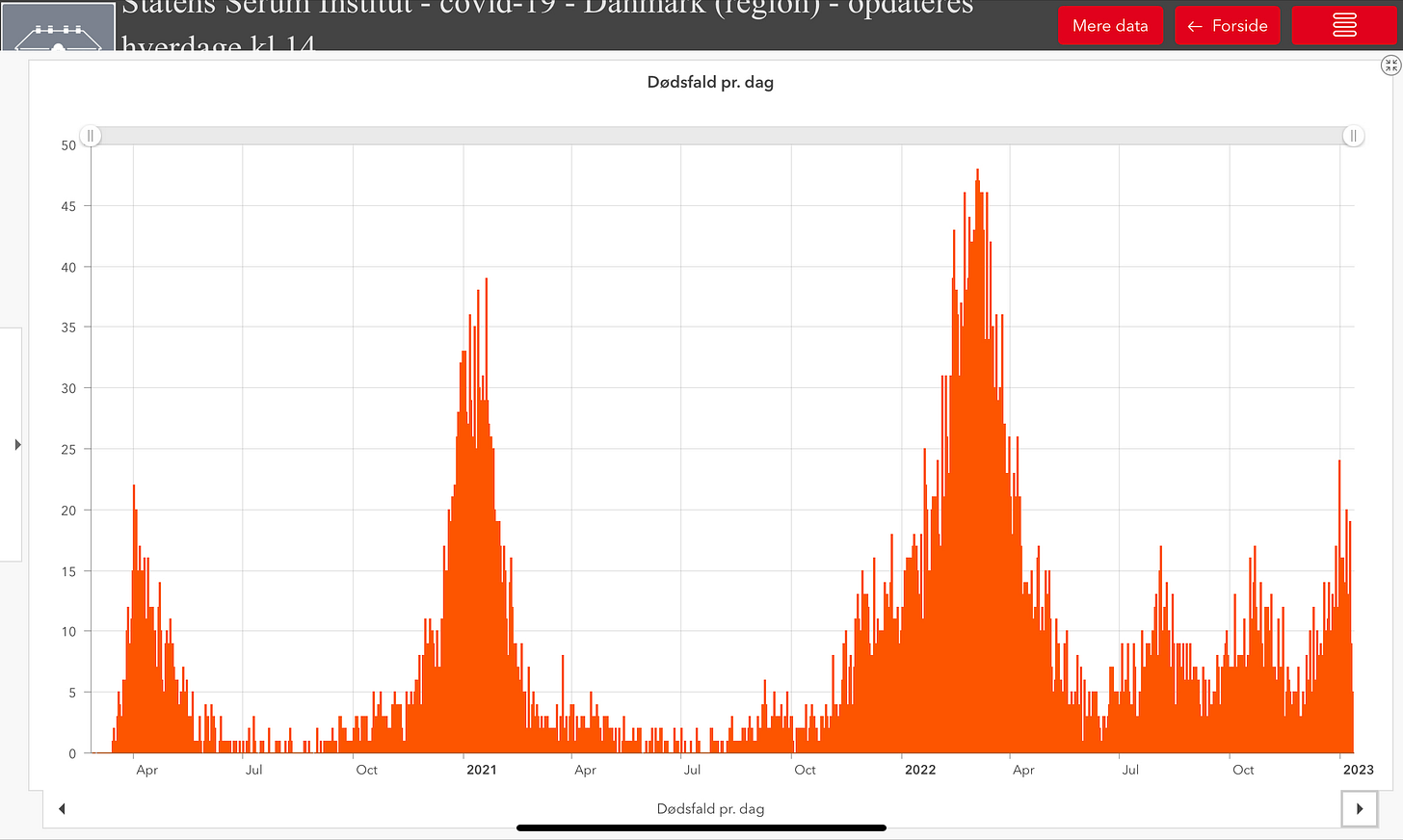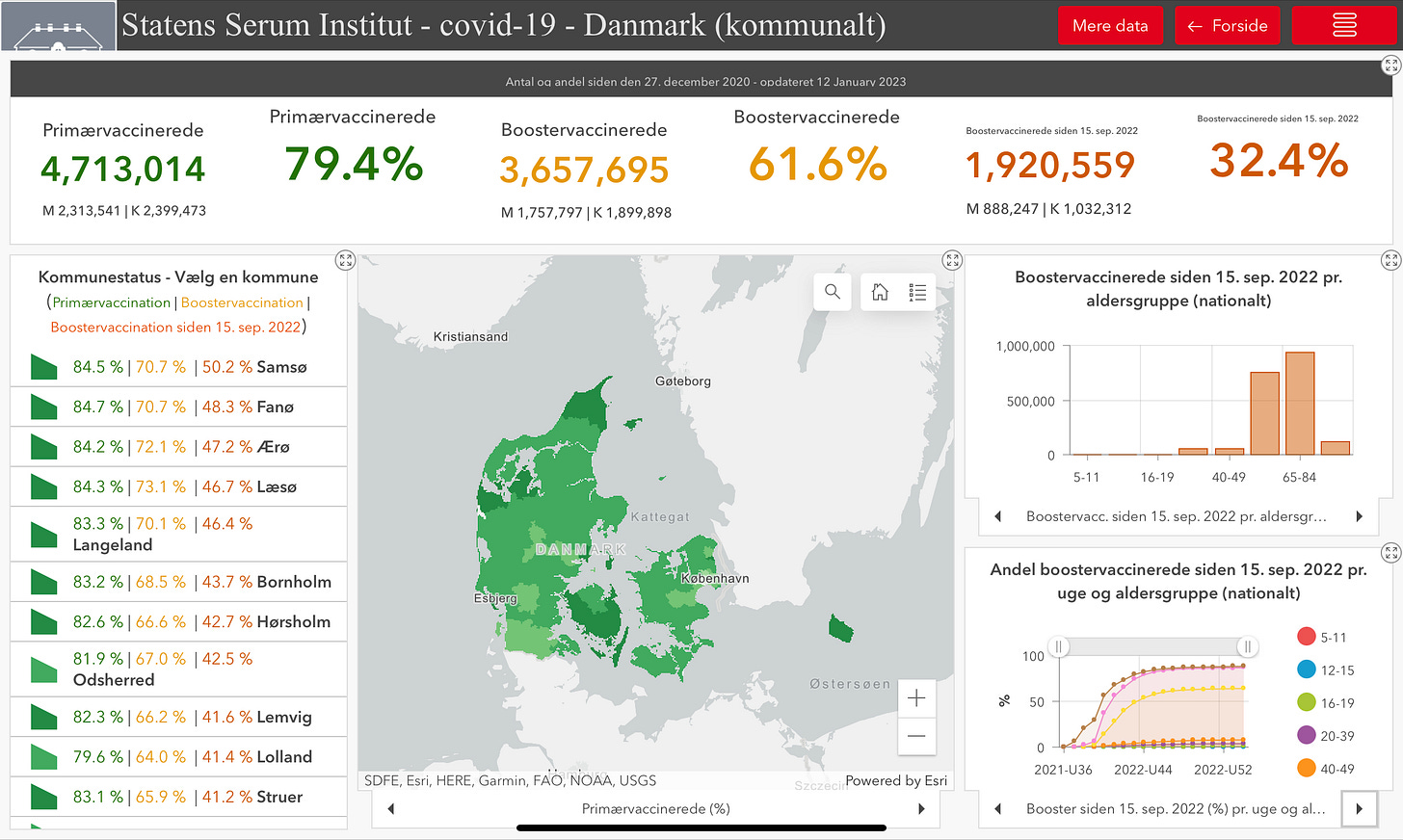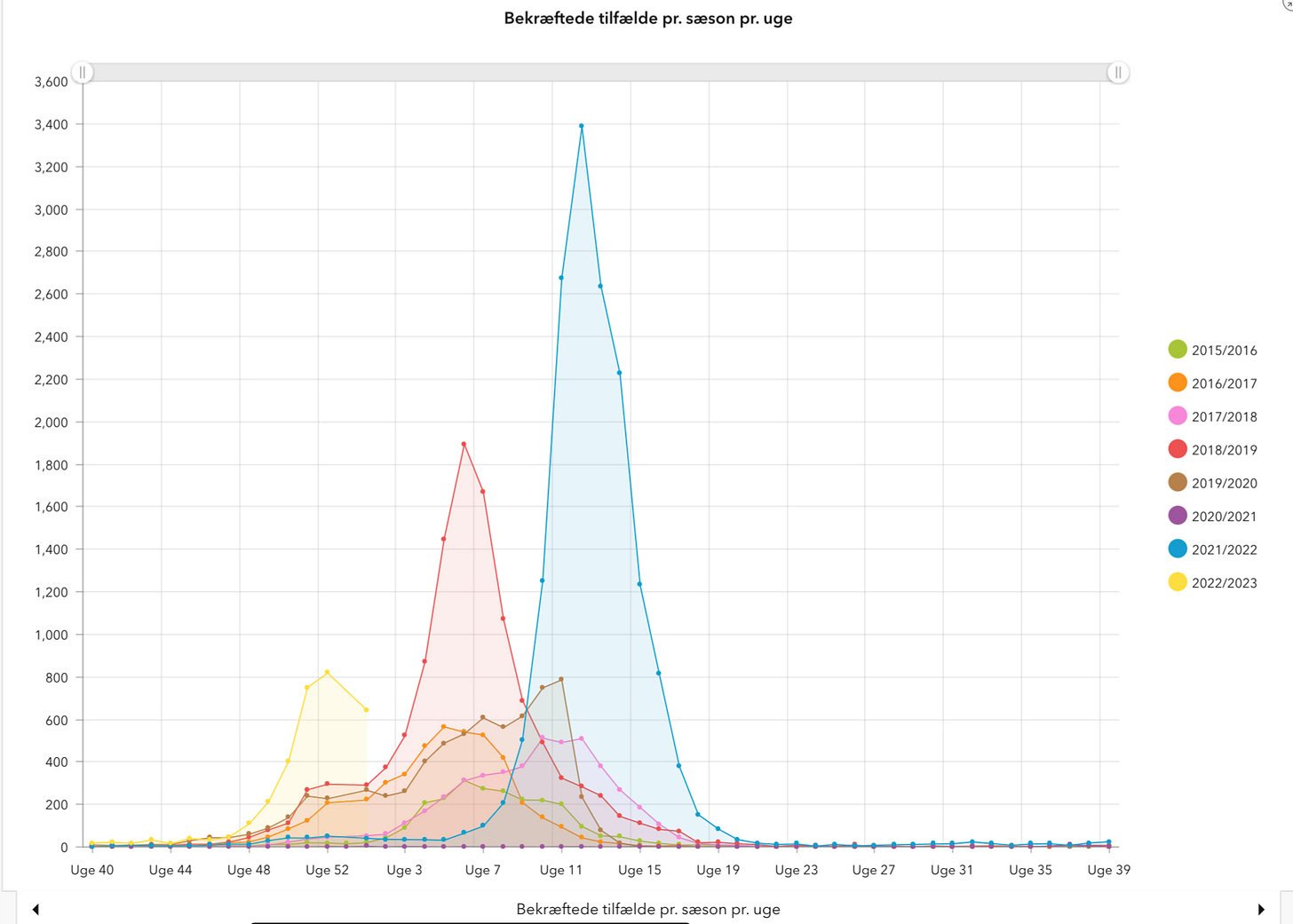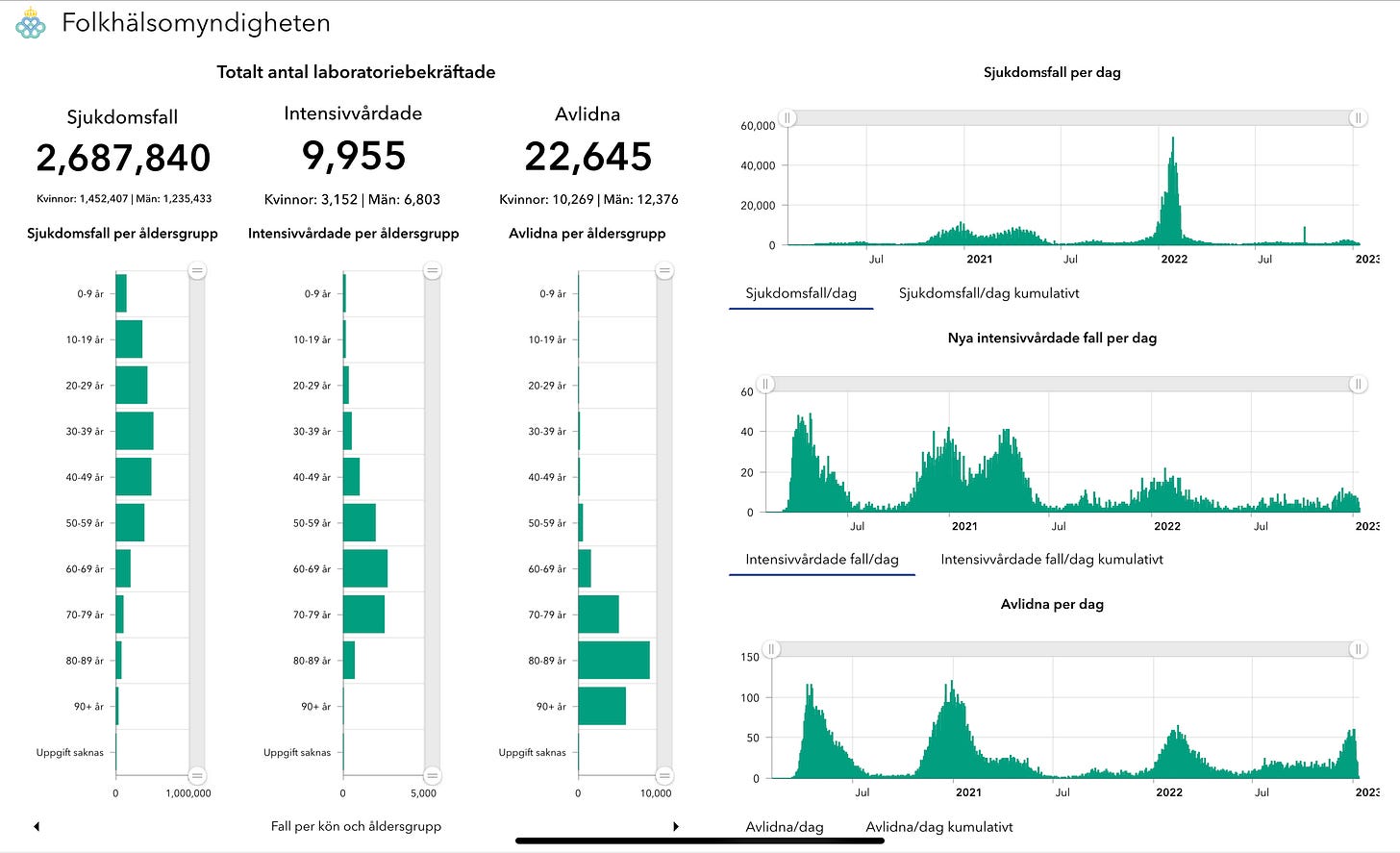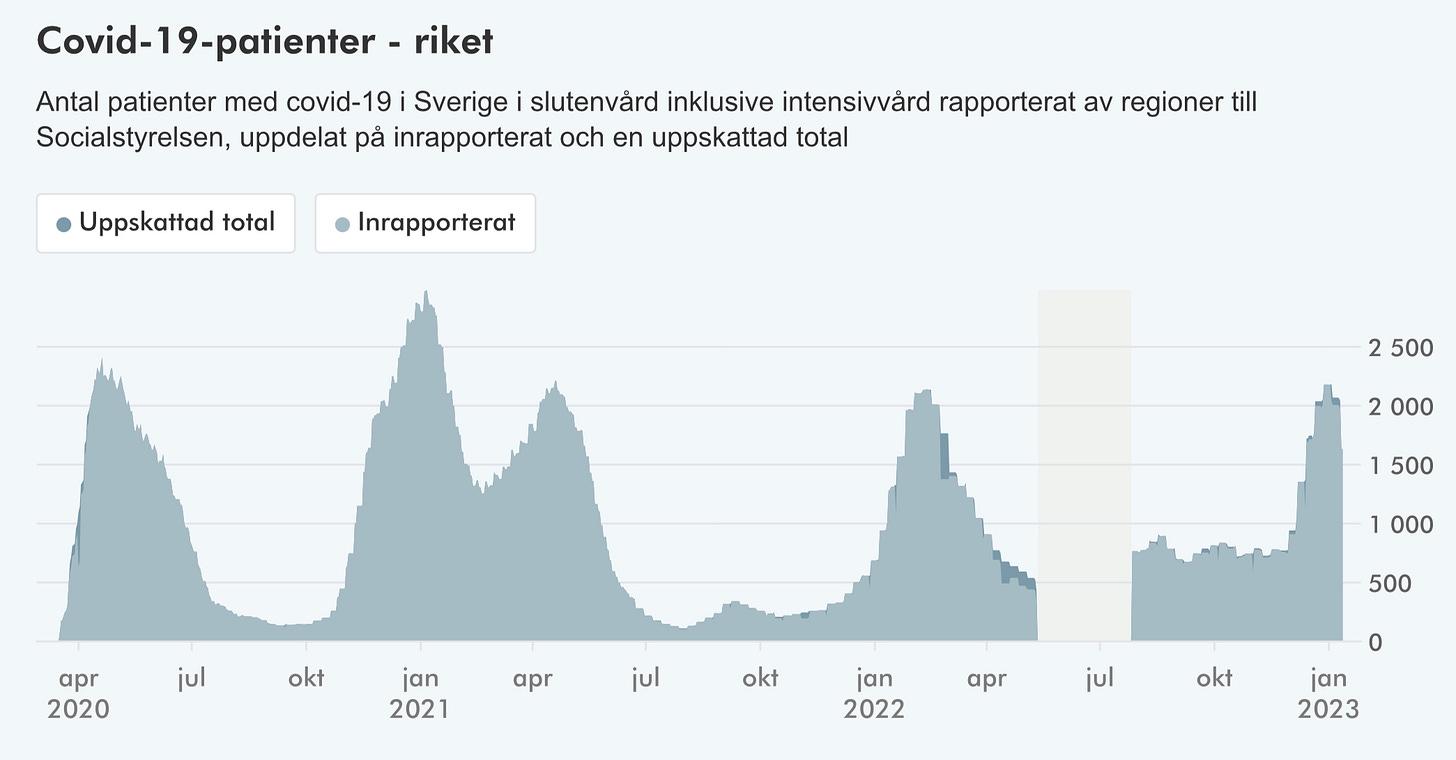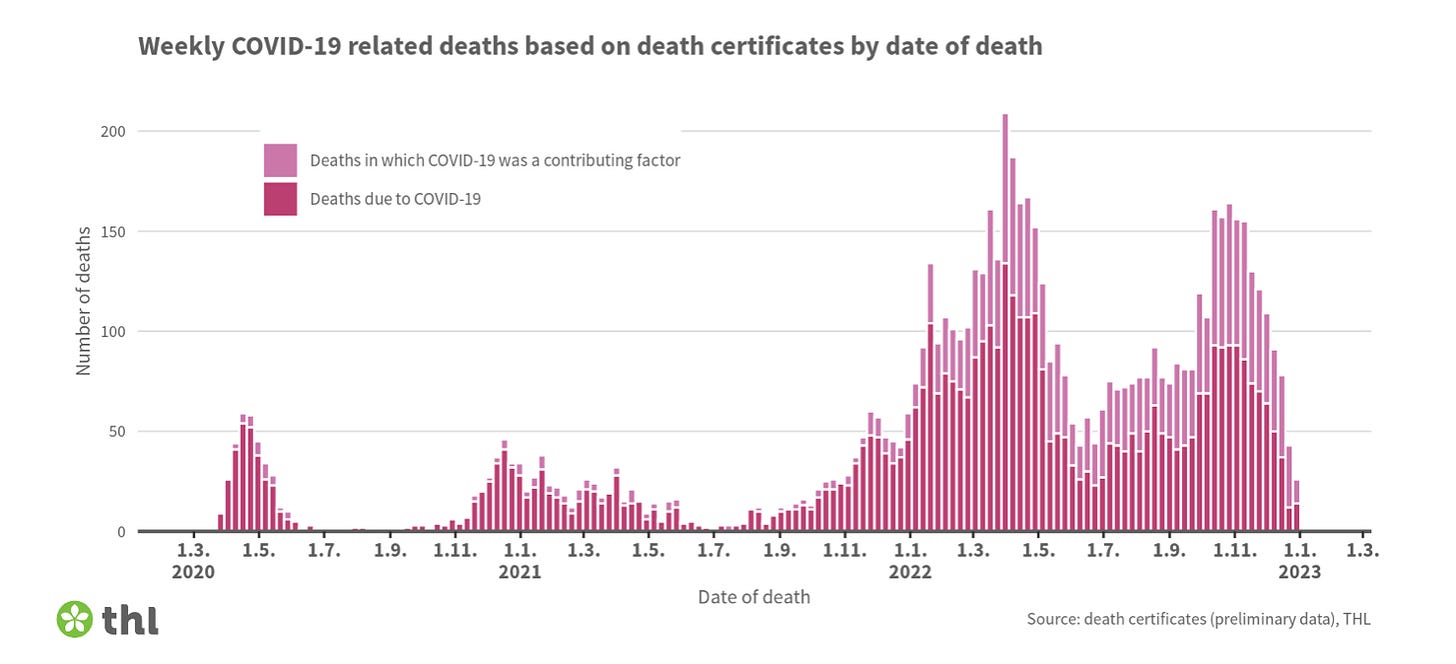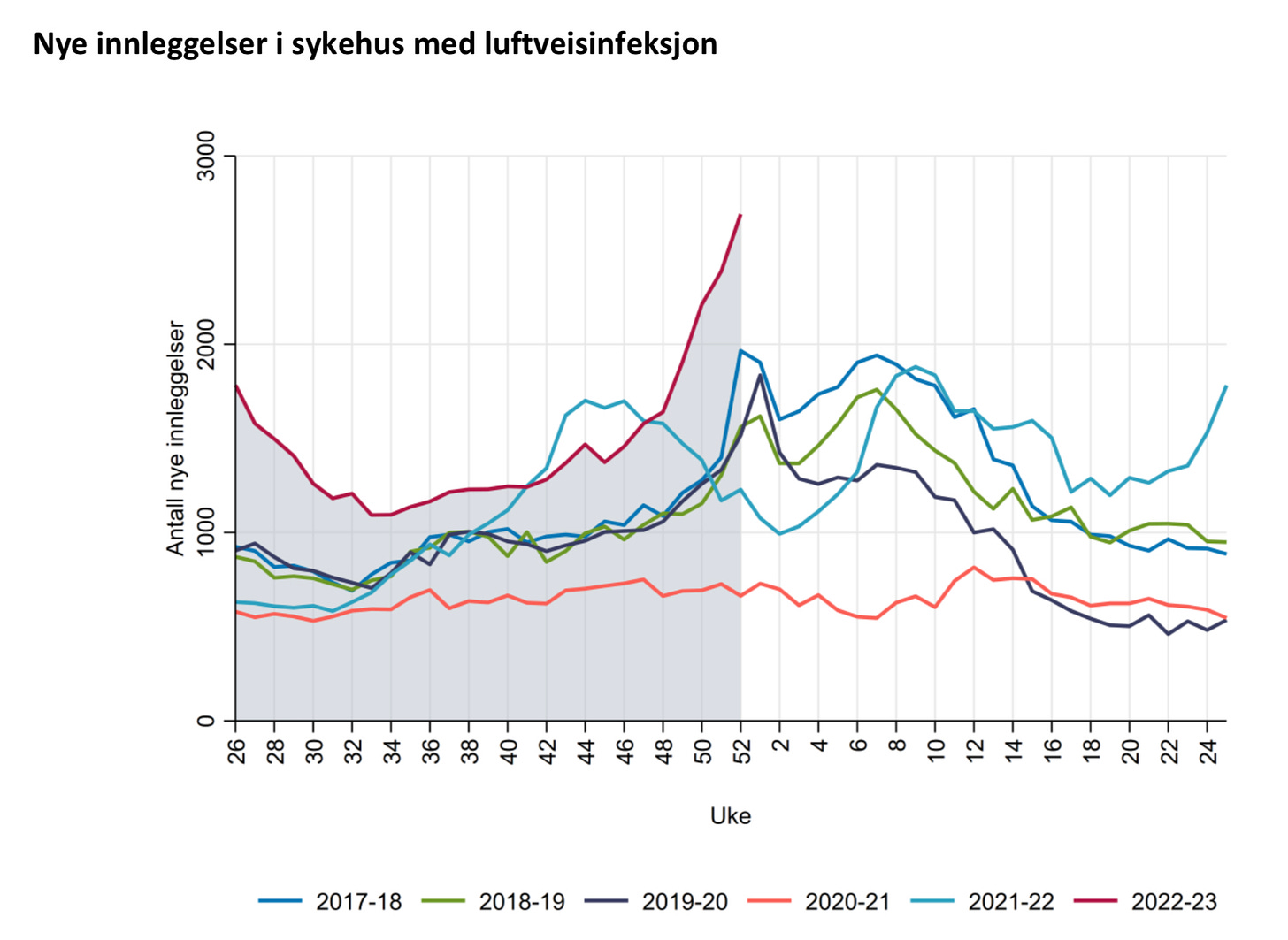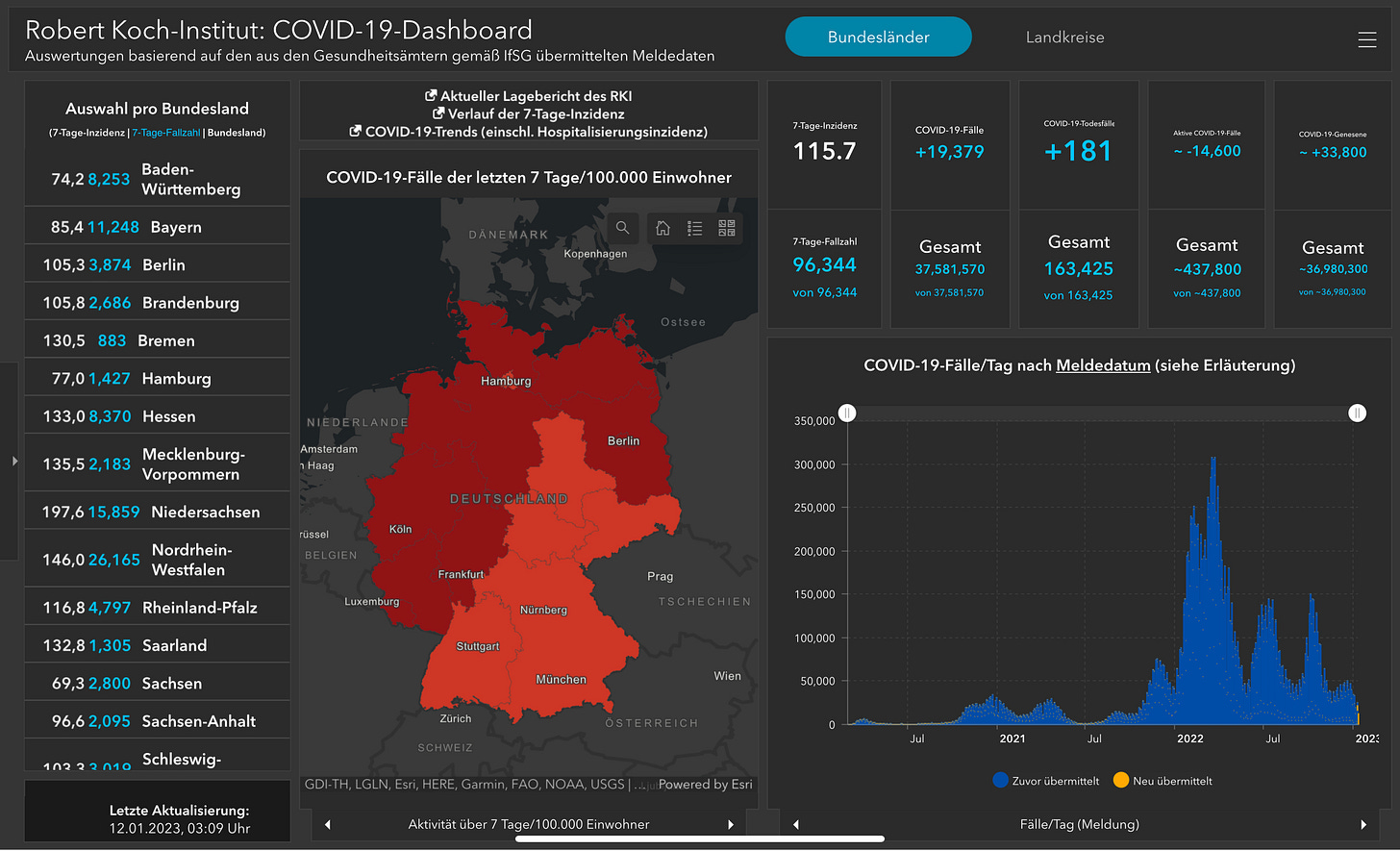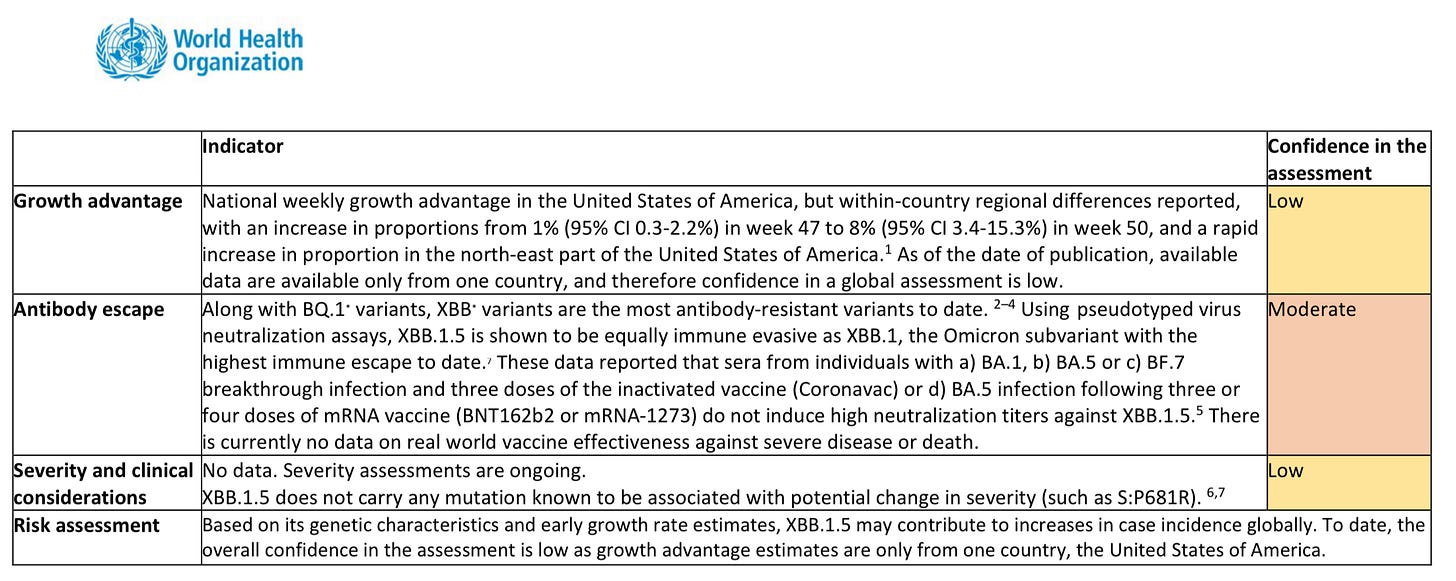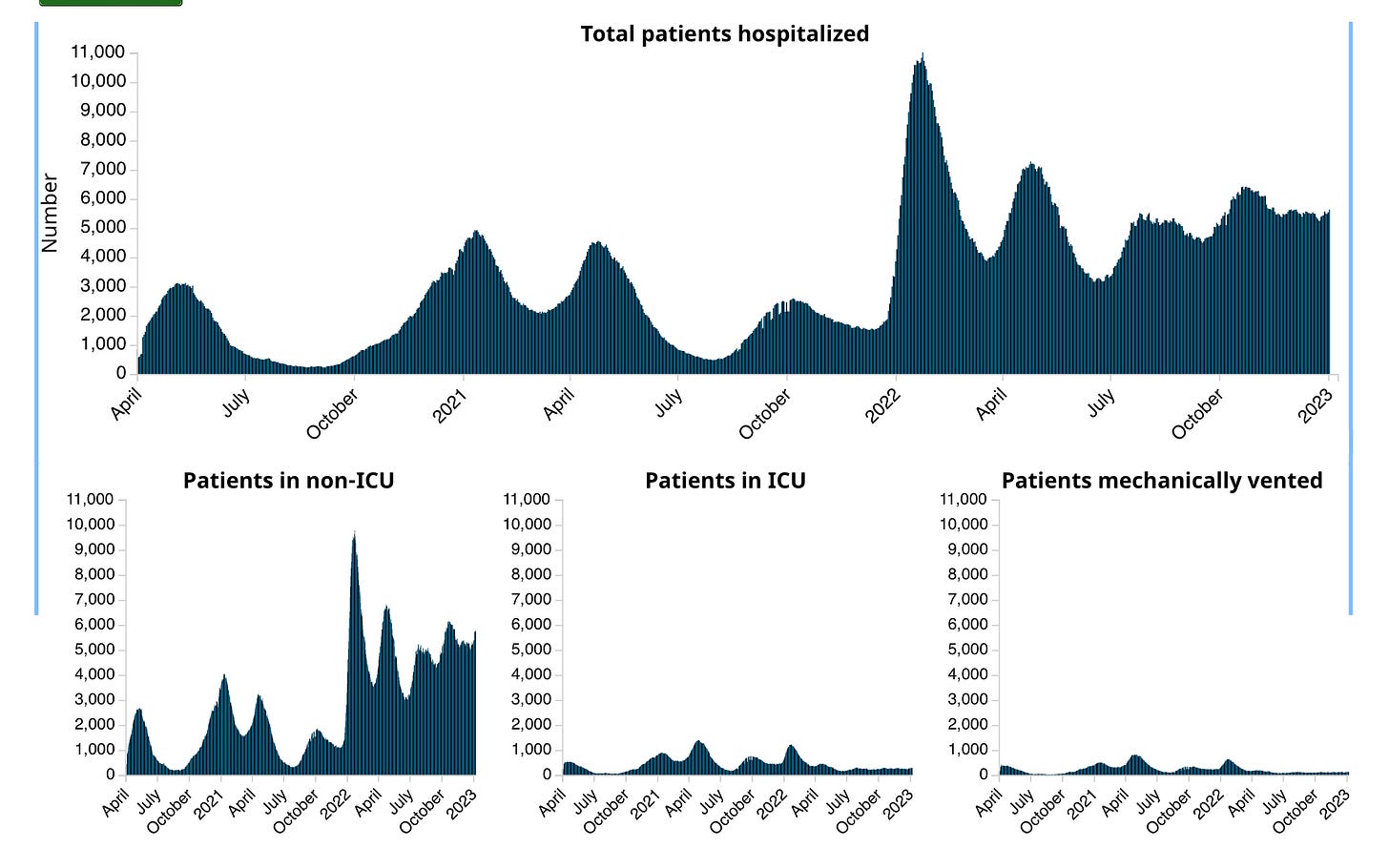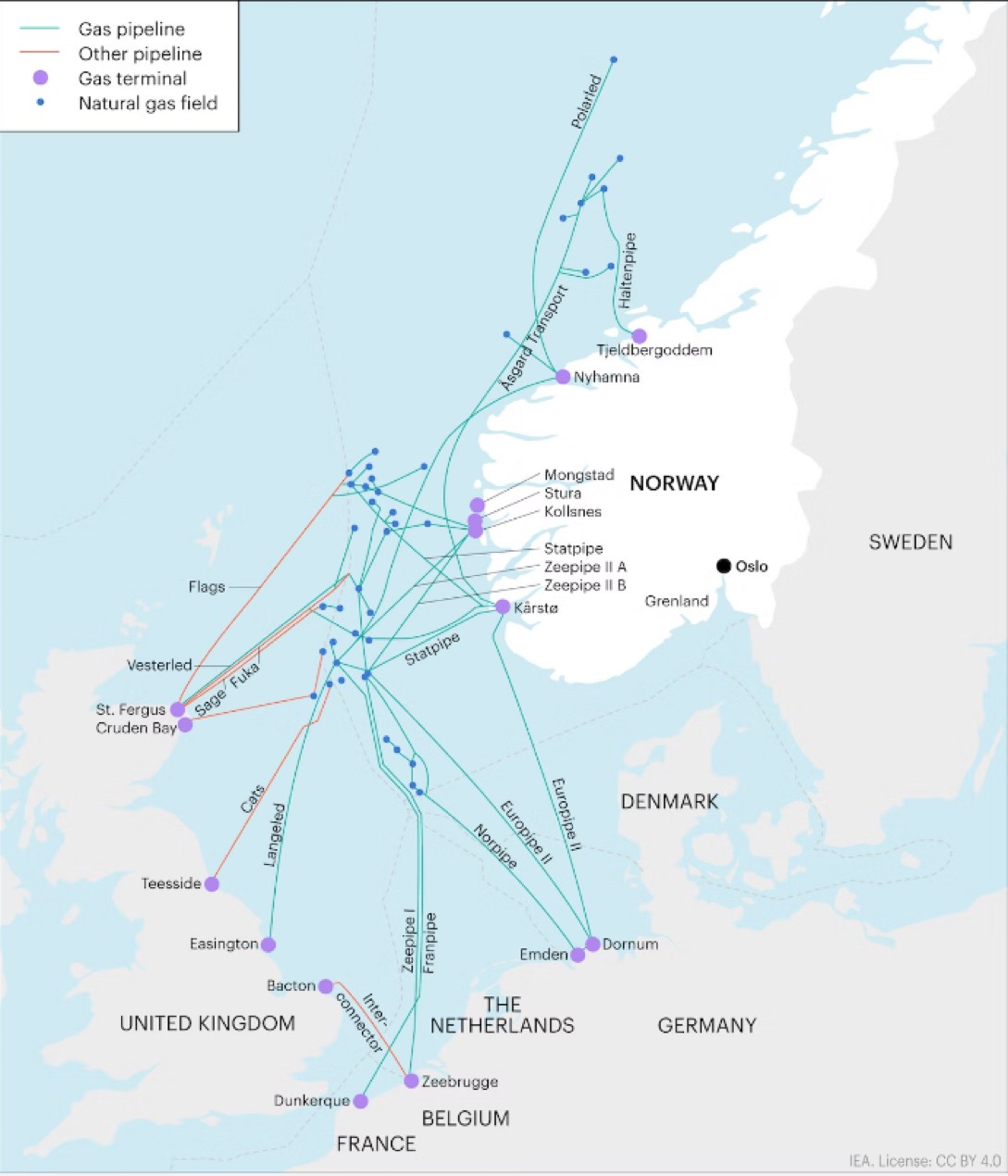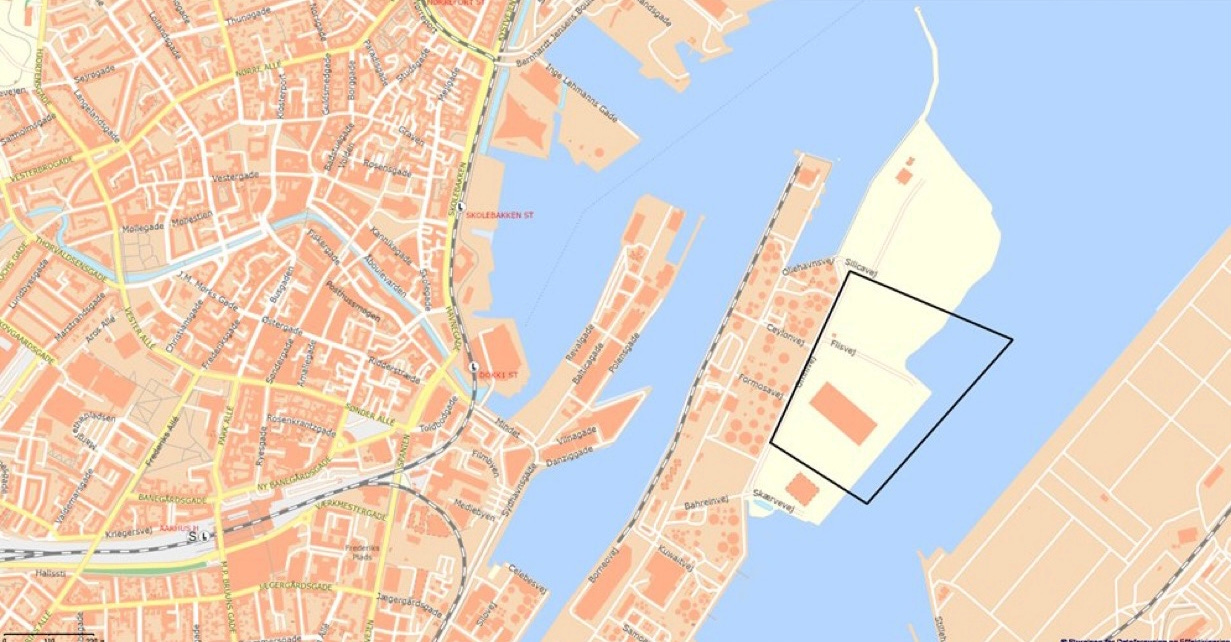🦠Pandemic🦠
🇩🇰
COVID infections and hospitalizations are dropping fast across Denmark, but coronavirus deaths remain very high. That is according to the latest weekly assessment from the Statens Serum Institute.
The news on infection numbers, which seem unusually low, comes as PCR testing increased slightly (+2.7%) last week. The virus incidence rate per 100,000 people fell from 115 to 77 from week to week, while the weekly positivity percentage dropped from 19.5% to 12.8%.
Professional Director Tyra Grove Krause:
“It is gratifying that we now see signs that coronavirus infection activity is decreasing. But there are still other respiratory infections in circulation in society at this time, such as influenza and RS virus.”
There was also a sharp drop in coronavirus activity as detected by COVID wastewater surveillance both nationally and across all five Danish regions. This is the third straight week of decreasing virus activity. The BQ.1 variant was the most detected of all virus strains in wastewater testing, making up 50% of all sequenced test results.
By age, infections declined across every age group. But, virus activity remains the highest among seniors 80 years old and older. Those 25 to 29 years old had the highest positivity percentage with 18%.
For a second week in a row infection activity among vulnerable seniors in care has declined. There weekend 339 confirmed infections last week. But, testing rates in nursing homes have also dropped. There were 31 coronavirus deaths among nursing home residents. Hospitalizations fell from 61 to 40 week to week.
Infection activity also declined among both hospital employees and senior care home workers.
The SSI has calculated that among those over the age of 50 who have had a second booster dose are approximately 74% better protected against a severe COVID infection, and hospitalization, and 81% better protected against death than those with three doses.
It remains a coronavirus variant soup in Denmark. BQ.1 and its sub-variants made up 42.97% of all sequenced positive test results in the first week of the year. BA.2.75 is trailing behind with 24.07% of infection activity. BA.5 and its many sub-strains make up 25.05%. The concerning new XBB.1.5 variant grew slightly week to week but overall isn’t commanding large numbers with 23 confirmed infections last week (1.86%).
“What these variants have in common is that they have several common mutations, which mean that they can infect people who have been previously infected or vaccinated to a greater extent than the other variants. There is no evidence that these variants are associated with more severe infections.”
-
COVID hospitalizations (457) continue to fall like a rock (-27) in #Denmark. While the number of severe #coronavirus infections in an ICU (14) and of those, the number on a ventilator (4) both inched down (-1 each).
Weekly COVID hospitalizations have plunged from 801 in the last week of 2022 to 642 in the first week of the new year. As it has been for over a year, seniors 70 to 89 years old continue to make up the largest proportion of new virus-related admissions. Hospitalizations also continue to be higher among those over the age of 50 who have either not had a second booster dose or who are not vaccinated at all.
Infection admissions to a psychiatric facility (79) dipped (-5)
-
Denmark reported just 360 new COVID infections (underreported), including 145 reinfections, and 11 more coronavirus deaths in the last day.
While hospitalizations fall and an unbelievably low number of daily infections is reported (unreliable), COVID deaths continue to be much too high. There were 96 coronavirus deaths in the last week of 2022, and 95 in the 1st week of 2023. The Statens Serum Institute says excess mortality, especially among those 75 years old and older, has “significantly increased” in the last few weeks.
SSI Professional Director Tyra Grove Krause:
“One must be aware that there may be a delay of a few weeks before falling infections, be it COVID or other respiratory viruses, can be expected to be reflected in mortality rates.”
-
With 4,811 PCR tests taken yesterday, the daily positivity percentage is 7.48%, over the last 7 days it is 11.2%.
-
On the vaccine booster dose front, 32.4% of the total population has a 2nd COVID booster dose. Among the target group of those 50 years old and older, booster dose uptake is 76%. That rises to 88% for elderly seniors over the age of 85, and 89% among vulnerable seniors in care.
-
The Statens Serum Institute’s sentinel surveillance found that besides coronavirus, influenza and metapneumovirus were the two most common respiratory infections found in the last two weeks of 2023.
The SSI notes influenza activity is the most frequently reported respiratory infection in the first week of the year. While RS virus numbers have stagnated and related hospitalizations have dropped.
“It is well known that a stagnation or minor decrease in influenza can be observed in relation to Christmas and New Year, when the flu season has started early.”
The SSI estimates that this years flu vaccine is 34% effective against the ‘A’ strain and 74% effective against the ‘B’ strain.
🇸🇪
Sweden has added 4,484 corona infections (wildly underreported) and another 503 virus deaths (!!!) in the last week.
COVID hospitalizations (1,634) are down (-372).
Vaccination statistics haven’t been updated since December.
-
The Swedish Public Health Agency is urging people to follow recommendations and safeguard themselves as much as possible with a continuing high level of infection activity for coronavirus, RS virus, and influenza. The agency notes that the holiday season may be skewing the statistical picture making it difficult to assess.
The number of confirmed infections in Sweden declined from the last week of 2022 and into the first week of the new year. But, infection numbers are extremely unreliable in Sweden, which restricts PCR testing to seniors in care and those being admitted to hospital.
The agency says there is still an intensive infection spread, with hospitalization numbers unchanged week to week and the number of deaths rising dramatically.
Continued high spread of infection
Health Investigator and Doctor Erik Sturegård:
“When we now return to schools and workplaces, there is an increased risk of infection spread. It is important that those who are sick with symptoms of a respiratory infection continue to stay at home and avoid close contact with others.”
The agency also continues to urge people to get vaccinated and boosted, for those eligible, in order to give themselves the best possible protection against severe infections. It says this advice also applies to getting this year’s flu shot.
-
While it continues to maintain that the explosive pandemic situation in China does not pose a significant risk to the coronavirus situation in Sweden, the country’s national health agency is urging better global COVID surveillance.
In its assessment that it handed over the government, the Swedish Public Health Agency does stress there is “great uncertainty” about China’s infection situation due to the country restricting coronavirus information. But, from information it, and other global health agencies, have access to, there doesn’t appear to be any new variants of concern circulating in China.
Director General Karin Tegmark Wisell:
“We do not assess that the spread of infection specifically in China will have a significant impact on the epidemiological situation in Sweden. However, we still have a pandemic with an extensive infection spread and a remaining risk of further waves to come. It is therefore very important that all countries together take global responsibility for COVID monitoring so that joint measures can be introduced when necessary.”
The agency says this means that all countries need to share up-to date knowledge and statistics in order to improve global preparedness for any new pandemic developments. Specifically, it says there is a need to stay vigilant for any new concerning variants, in China, or any other country.
Again, Sweden is as guilty as any country in kneecapping virus surveillance as it restricts PCR testing to just a few eligible groups. It is far from alone, as globally testing and sequencing are happening in a tiny fraction of the numbers seen for the first two years of the pandemic. The World Health Organization has also been pleading for a major improvement in global virus surveillance. Director General Dr. Tedros Adhanom Ghebreyesus warned on Thursday that “we can’t beat this virus with our eyes closed.”
-
A pilot project has been launched to extend COVID wastewater surveillance to Arlanda International Airport near Stockholm. The Swedish Public Health Agendy says this could be a valuable asset to existing measures to monitor for coronavirus activity potentially coming from China. However, the agency warns that due to some technical limitations there will be limited ability to detect any new virus variants.
Director General Karin Tegmark Wisell:
“The value of such monitoring is above all to be able to follow changes in virus levels and which virus variants dominate from entry to Arlanda over time. The Public Health Agency will therefore, during the month of January, together with a research group at the Royal Institute of Technology, carry out a pilot project, where samples will be taken from the wastewater at Arlanda.”
Sweden currently requires travelers arriving from China to have a negative COVID test no more than 48 hours old in order to enter the country.
🇫🇮
Finland registered 2,259 new infections and eight more virus deaths in the last week.
🇳🇴
Uncertain. That is how the Norwegian Institute for Public Health is describing its infection situation in the first week of the year. It says the holiday season and an ebb in monitoring are clouding the situation. In its latest weekly pandemic assessment, it says the latest COVID wave is “probably past its peak” but another infection wave could arrive later this winter. Will the influenza epidemic continue to increase? Uncertain. The RS virus? It is “probably” close to its peak.
The NIPH says two things with a degree of confidence. One, the number of respiratory infections bouncing around is very high. Two, it is seeing more people pouring into hospitals with a respiratory infection “than all the years before the pandemic.”
With a coronavirus wave ebbing, the agency says it is influenza that is the biggest concern at the moment. It says flu cases were increasing rapidly going into Christmas but then decreased a little last week. Will flu cases continue to decline? Uncertain.
There were 848 influenza-related hospitalizations in the last week of 2022, a number the NIPH described as “a very high number.” There were 500 more admissions last week. Almost all influenza infections (98%) are the ‘A’ strain.
So far, 63% of seniors 65 years old and older have a flu shot. For those 18 to 64 years old who are in high-risk groups, influenza vaccine uptake is just 34%. For kids under 17 it is a measly 7.2%.
As for the RS virus, the health agency says the majority of hospitalizations continue to be children under the age of five.
Hospitalizations due to a respiratory infection increases in the first week of January to 2,691 new admissions, 304 more admissions than the week previous. The big three, coronavirus, influenza, and RS virus continue to dominate.
COVID infections (unreliable) “seem to be decreasing” as are virus-related hospitalizations, with 205 admissions last week, directly due to a COVID infection. However, wastewater surveillance registered a small increase in virus activity last week.
Norway suffered another 93 pandemic deaths in the last week of 2022 and then 90 more in the first week of January.
The NIPH says the BQ.1.1 variant is dominant in Norway at the moment. But, BA.2.75 and XBB variants are also growing in frequency.
73% of seniors 75 years old and older and 60% of those 65 to 74 years old have a 4th COVID vaccine dose.
🇩🇪
Germany recorded 19,379 new corona infections and another 181 pandemic deaths in its Thursday report.
It also added 1,712 more hospitalizations, while ICU numbers (1,151) decreased (-63). As a percentage of all intensive care beds in the country, severely infected people are using 5.5%.
WHO/🦠
The World Health Organization’s Technical Advisory Group on Virus Evolution has released a ‘rapid risk assessment’ of the XBB.1.5 variant. In a nutshell, it basically says while they are moderately sure the strain is very immune evasive, there is still an LOT we don’t know about it yet.
🇨🇦
COVID hospitalizations are still rising in Canada. The overall number of beds being used by pandemic patients in the week ending January 9, increased to 6,132, which is 493 more than the seven days previous. Of those, general admissions rose by 365 to 5,736 beds in use. Intensive care numbers also edged upward from 267 to 277. While the number of severely infected people on a ventilator inched down by one to 119.
-
A Statistics Canada report on excess mortality during the pandemic contained some pretty eye-opening numbers. Among them were big increases in the number of deaths due to drug overdoses and alcohol abuse.
Accidental poisoning or overdoses from either over-the-counter or illicit drugs claimed 4,605 lives in the first year of the pandemic and another 6,310 in the second year. This is drastically higher than the death toll from the height of the opioid crisis in 2017, which claimed 4,830 lives. StatsCan says people under the age of 45 made up a disproportionate number of overdose deaths.
2020 also saw the largest year-over year increase in alcohol-related deaths in the last two decades, an 18% increase, with a loss of 3,790 lives. In 2021, it rose again with 3,875 deaths.
The statistics agency says from when the coronavirus arrived in March of 2020 until August 2022, there were 7.6% more deaths than there would have been if there hadn’t been a pandemic. 53,741 Canadians lost their lives, and of those at least 42,215 deaths were directly because of a COVID infection.
Canada saw its deadliest week of the pandemic and its highest weekly rate of excess mortality during the Omicron wave. Specifically, in the third week of January 2022 there were 26.8% more deaths than expected. To put it a different way, StatsCan says in that week one out of every five deaths would otherwise not have happened. In the first two months of 2022 excess mortality in Canada rose by 16.8% with 8,285 more deaths than normal. On a provincial level, Alberta and British Columbia recorded higher than expected weekly deaths through much of 2022.
⚡️Energy Crisis⚡️
🇩🇰
Danes have heeded the call to conserve as much energy as possible due to the ongoing energy crisis as Russia weaponizes its energy exports by turning gas flows to Europe off. Heading into the fall, European countries have scrambled to top up natural gas reservoirs, seek new energy sources, and battle soaring energy costs. One of the big messages across the EU was for businesses and people to reduce their energy use as much as possible in order to try and ease the strain on the system and conserve gas use. According to numbers from Statistics Denmark gas consumption has fallen by 37%.
Arbejdernes Landsbank Economist Brian Friis Helmer, speaking to DR, says skyrocketing gas prices were the main driver for a sharp decrease in use.
“Since the peak this summer, the price of natural gas has fallen back quite a bit, but it is still at a higher level than it was two years ago.”
Helmer says the sudden pedal to the metal energy transition and an unprecedented winter heat wave also played a role.
Green Power Denmark says the reduction in gas use is quite astonishing.
Energy Analyst Kristian Rune Poulsen:
“It is eye opening. We have been in the process of reducing our gas consumption for a long time, but this reduction corresponds to what we have perhaps achieved in the last 10 years. It has gone very, very fast and has been very sudden.”
The data on the huge reduction in gas use from Statistics Denmark doesn’t differentiate between companies and individual households. It simply says Denmark as a whole has seen a 37% reduction.
“In any case, it is extremely important that we have been able to save so much. This puts us in a favorable situation. The energy crisis is not over, and it is something that will last for many years to come. There is still a long way to go before we are free of gas. Some of the decline can perhaps also be explained by the reaction to the energy crisis, where people have switched to other fuels that are easier to get hold of right now. So there is still a long and tough journey before we are free of gas.”
🇳🇴/ 🇪🇺
Norway has become Europe’s main supplier of natural gas, with Norwegian gas production and exports being the single most important building block to European energy security. It is also a prime example of how Russia’s strategy of weaponizing its energy exports in an effort to bend the EU to its will has completely failed. Not only did Russia not freeze Europe into submission, it permanently eliminated its single biggest customer while incurring punishing sanctions.
Norway exported 113 billion cubic meters of gas to Europe last year, a 3% increase from 2021. It finished the year by hiking European gas exports by 10 billion cubic meters in December alone. This is thanks in part to the Baltic pipeline, which officially opened in November. This also means huge revenues for Norway as it saw nearly €160 billion in gas revenues last year.
🇺🇦/ 🇷🇺 War
🇵🇱/ 🇺🇦
The impasse in Europe over sending Ukraine more modern Leopard tanks appears to have broken. Poland, as part of an international coalition, will deliver a company of Leopard tanks to Ukraine. A company usually consists of 10 to 12 tanks.
Polish President Andrzej Duda received a heroes welcome as he visited the Ukrainian city of Kyiv on Wednesday.
“A company of Leopard tanks will be handed over as part of coalition building. We want it to be part of an international coalition.”
The more modern and powerful Leopard 2 tanks have long been on Ukraine’s weapons wish list. The move by Poland increases pressure on Germany to follow suit. Germany has played with the idea of sending Ukraine Leopard tanks but then folds when push comes to shove.
The tanks feature a 120-millimeter cannon and can track and engage targets up to 4,000 meters away in broad daylight or in the darkness of night.
🇬🇧/ 🇺🇦
Britain looks to be also sending more tanks to Ukraine. UK Prime Minister Rishi Sunak told reporters that he has instructed Defense Secretary Ben Wallace to “move further and faster” to support Ukraine, including supplying it with British Challenger 2 tanks.
🇺🇦/ 🇪🇺
Ukraine hopes to become a part of the European Union. It has begun the process of joining the trading bloc, but the process, which can take many years, seems to have hit another snag. European Commission Vice-President Frans Timmermans said this week that Ukraine cannot join the EU while it is partially occupied by Russia.
“The whole idea is to make sure that Ukraine comes out of this conflict victorious, sovereign, independent, free, and has the opportunity to make this choice itself. And I think Ukraine is fighting to make this happen.”
🇵🇱 🇱🇹 🇺🇦
Poland, Lithuania, and Ukraine have signed a Joint Declaration underscoring the common ties between the three countries, areas where the three can cooperate on, and working together towards getting Ukraine into the European Union and NATO.
President Volodymyr Zelenskyy, President of Lithuania Gitanas Nausėda, and President of Poland Andrzej Duda signed a Joint Declaration, called the Lublin Triangle, in Lyiv on Wednesday.
The document states that Lithuania and Poland will continue to provide strong military, technical, defense, humanitarian, and other support to Ukraine. All three countries also reaffirmed support for the establishment of a special international tribunal for war crimes committed by Russia in its invasion of Ukraine.
🇬🇧/ 🇷🇺
NATO forces continue to keep a close eye on the Russian warship, Admiral Gorshkov. You will remember that Norwegian forces were tracking the vessel on Friday as it sailed in international waters along the Norwegian coast. Now it is sailing around the North Sea, where it is being shadowed every step of the way by the British navy. One of the reasons the vessel is drawing so much interest is that it carries Russia’s newest hypersonic missiles and also employs Russian stealth technology. Its course close to the Norwegian, British, and European coasts but still in international waters, is likely an intimidation effort.
🇱🇹/ 🇺🇦
Lithuania is committing €40 million in military aid to Ukraine for this year. The Baltic state is beginning by delivery more air defense systems to Ukraine.
🇱🇹
Hope for the best and prepare for the worst. The Lithuanian government is launching an information campaign to prepare its citizens for a possible crisis. The Ministry of the Interior says with the current security situation and sharing a border with Russia things have the potential to unravel quickly and people need to be prepared. Although the ministry stresses this is a just-in case measure and there is no direct threat to Lithuania at the moment.
Interior Minister Agne Bilotaite:
“The COVID pandemic, illegal immigration, Russia's war against Ukraine, the unpredictability of our neighbor Belarus, and the Astravets nuclear power plant near Vilnius, these are the challenges we have experienced one by one.”
Among other things, the information campaign advises Lithuanians about safe locations in an emergency and how to prepare a survival pack.
🇩🇰
The website of the Danish Ministry of Finance was the victim of a cyber attack on Wednesday. It looks like it was a denial of service (DDoS) attack where hackers unleashed millions of requests on servers seeking to overload them and shut them down. This follows a similar cyber attack on the Danish banking sector earlier this week.
-
A cargo ship containing U.S. military equipment will dock in Aarhus today. East Jutland police are warning that a temporary restricted area will be set up in the dock area around the ship. The no-go zone will likely remain in place until February 12.




